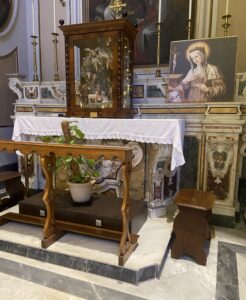A Visit to Cloister of San Francesco in Sorrento
A memorable visit to Chiostro di San Francesco with a special tour by a Friar Antonio
The people of Sorrento have a special relationship with Franciscan friars. They say friars bring good luck as well as humility being the fundament of Christain life. Studying journalism at a Franciscan university, we share that special connection.
Located in the Piazza Francesco Saverio Gargiulo in Sorrento stands at 14 th century cloister across from a green, public, palm-shadowed garden. Alongside the Chiostro di San Francesco d’Assisi, is the basilica, which is dedicated to Sorrento’s patron saint. Both of the holy, historical structures are worthwhile.
The history of the monastery is fascinating. Built as a 9 th -century convent, the Church of Saint Francis is the oldest standing structure in Sorrento. In the Middle Ages, the city acted as a fortress and was surrounded by walls to keep out pirates and Ottoman invaders.
The convent was the only thing built outside of these walls and because of this, the nuns feared the constant attacks. In 1224, the first Franciscan friars came from Naples to Sorrento, and in 1231, they took over the convent so that the nuns could go live within the walls where it was safer.
Now, here is where it gets interesting: the monastery’s open, fairytale-like courtyard, accessible through a small door from the church, is surrounded by two types of arches. Some arches are rounded while others are pointed. The rounded arches were put in later by the friars, in 1400, to represent the Ottoman-style architecture to promote a sense of unity and acceptance. This might have seemed like an odd decision for the time. However, when the Turks invaded Sorrento on June 13, 1558, any potential controversy paid off.
With 120 ships in the bay of Sorrento, the Turks destroyed the whole city before getting down to the monastery. This is where the friars attempted to provide safe passage for the residents of the city through a door connected to the marina in the courtyard. The invaders came in and were going to destroy the monastery and kill everyone inside. This was until they saw the rounded arches. This symbol of unity and respect for their culture kept them from destroying the building and saved everyone inside.
After this terrible event, the viceroy of Naples built watchtowers along the coast to notify other towers of upcoming dangers. The monastery has stood proud ever since and even though the church was destroyed by the earthquake caused by Pompeii, it has since been rebuilt to look just as beautiful as ever.
Your first sight entering the church may be the large painting of St. Francis receiving the stigmata. Upon first glance of the church, for one not familiar with the significance of every painting and structure, you can simply take in the ornate beauty of everything appearing in front of you.
The church has one central chapel and six others, where statues of San Francesco, Sant’Antonino da Padova, Santa Rita da Cascia and the Madonna Immacolata stand. The altar of the main chapel holds a large gold cross surrounded by candles and is backed with a huge painting and detailed pillars. The yellow and white interior makes the space feel friendly and safe, yet also serene, just as a church should be.
Along with getting to view the beautiful church, we had the honor of meeting and hearing Friar Antonio’s wise words. He prayed and blessed our group.
Br. Antonio then gave us all the unique experience of a special benediction. One by one, the group members stepped forward to have him place his hands on their heads. For a moment, he would stand there with his eyes closed thinking intently and sometimes making small chuckles or worried looks. Then, he would either say he had nothing to say or make a little observation of something about them whether it be reassurance, something they could do better, or a piece of advice.
It was the kind of experience that is incredibly hard to explain to someone who was not there to witness it firsthand, but we think he made sure we all heard what we needed to hear on that special day. If you ever have the opportunity for a similar experience, or even just to view the church and monastery, be sure to take it.
Friar Antonio said The Chiostro di San Francesco was the only convent to survive with all Franciscan friars after the attacks and Mount Vesuvius’ 1600 earthquake. Something had been keeping this structure from collapsing countless times. The reason, is that’s up to you.









